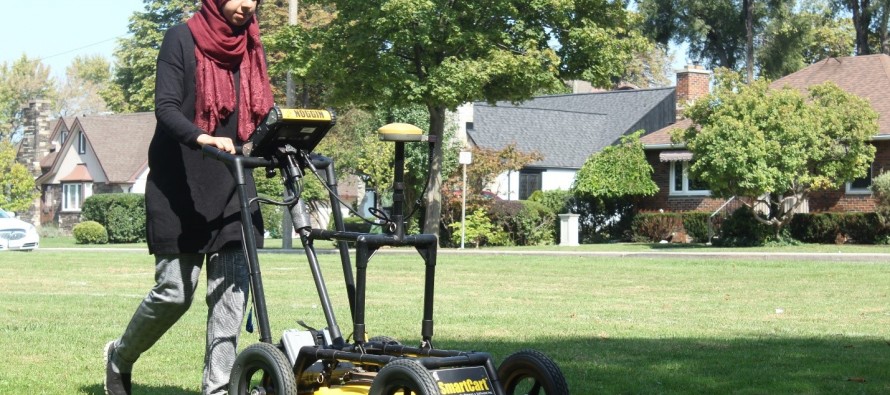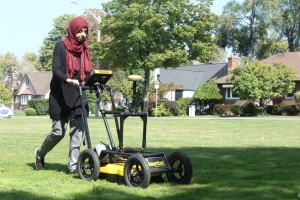Digging through history


Mariam Ageli is experimenting using ground penetrating radar at the WeDigHistory Project in Assumption Park on Saturday Sept. 24.
By Dawn Gray
A team of scientists, archeologists, and historians are inviting the public to help celebrate Canada’s 150 by digging deeper into the history of Windsor.
This past weekend, people could learn more about the history of the Assumption park by doing geophysical testing using machines to see what is below the ground without actually having to dig.
The WeDigHistory Assumption Park Geophysics and History project is being financed by a Community Fund for Canada’s 150th and is made up of two parts: a scan-a-thon where community members can bring in old photos of the area to be put in a digital archive, and a geophysical survey that took place over the weekend to search for evidence of buried structures in Assumption Park.
At the park, the team is hoping to find evidence of wooden buildings that once stood there from even before Canada was founded in 1867. The structures date back to the 1700s and are associated with the Huron Mission and the Assumption Church that still stands today.
The “dig” used machines such as ground-penetrating radar and magnetometers. These machines send different types of signals into the ground and when they hit resistance, they bounce the signals back to produce readings. What the team is looking for are anomalies that will allow them to map out the underground remains of old structures.
According to Dena Doroszenko, senior archeologist with the Ontario Heritage Trust, their goal is not to unearth the history but to protect it.
“Often people think that once we do these geophysical tests that we go and dig. Well, we don’t really need to because were more interested in preservation,” said Doroszenko.
Assumption Park is owned by the City of Windsor and is protected by a conservation easement obtained by the Ontario Heritage Trust, on the basis of its archeological potential. This project will also help to guide the city in any future public works done to, or near the park.
“The city will have to do archeology first, whether it’s trail developments, sidewalks, tree planting because it is protected by conservation easement.”
This area just east of The Ambassador Bridge has a rich history and was used by many different people during different eras, according to Guilluame Teasdale, an assistant professor of history at the University of Windsor’s and the project historian of WeDigHistory.
“Aboriginal people, French people, British people. There used to be a lot of things on this ground right here,” said Guilluaim. “We suspect that there are artifacts, tools, remains of building, may even be some skeletons.”
Maria Cioppa, professor University of Windsor’s department of earth and environmental sciences is co-director of the historical archeological study. She says she is hoping the project will help to come up with a better idea of how things have changed over our history of more than 150 years.
“We are digging into historical records and digging into the ground…although we are not doing any actual digging,” said Cioppa. “Once all the digital data is collected from the scanned historical pictures and the geophysics of the area, the project team will construct a virtual museum so people can look through history, from present day to as far back as we possibly can.”
This project is being funded by the Windsor Essex Community to celebrate Canada’s 150th.
Cioppa applied for the funding specifically for this project and said the timing was perfect.
“History, to me, is so significant especially in this area and in the development of Canada as a country,” said Cioppa. “That’s why we thought Canada 150 would be a great time to do this.”
“To process all the information gathered into a map form will take a while, it’s a lot of data. We’re hoping to have the digital history online through the Leddy Library by the end of the year. A good way to end the Canada 150 celebrations.”


